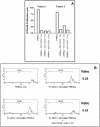Plasmodium vivax: induction of CD4+CD25+FoxP3+ regulatory T cells during infection are directly associated with level of circulating parasites
- PMID: 20224778
- PMCID: PMC2835751
- DOI: 10.1371/journal.pone.0009623
Plasmodium vivax: induction of CD4+CD25+FoxP3+ regulatory T cells during infection are directly associated with level of circulating parasites
Abstract
Circulation CD4(+)CD25(+)FoxP3(+) regulatory T cells (Tregs) have been associated with the delicate balancing between control of overwhelming acute malaria infection and prevention of immune pathology due to disproportionate inflammatory responses to erythrocytic stage of the parasite. While the role of Tregs has been well-documented in murine models and P. falciparum infection, the phenotype and function of Tregs in P. vivax infection is still poorly characterized. In the current study, we demonstrated that patients with acute P. vivax infection presented a significant augmentation of circulating Tregs producing anti-inflammatory (IL-10 and TGF-beta) as well as pro-inflammatory (IFN-gamma, IL-17) cytokines, which was further positively correlated with parasite burden. Surface expression of GITR molecule and intracellular expression of CTLA-4 were significantly upregulated in Tregs from infected donors, presenting also a positive association between either absolute numbers of CD4(+)CD25(+)FoxP3(+)GITR(+) or CD4(+)CD25(+)FoxP3(+)CTLA-4(+) and parasite load. Finally, we demonstrate a suppressive effect of Treg cells in specific T cell proliferative responses of P. vivax infected subjects after antigen stimulation with Pv-AMA-1. Our findings indicate that malaria vivax infection lead to an increased number of activated Treg cells that are highly associated with parasite load, which probably exert an important contribution to the modulation of immune responses during P. vivax infection.
Conflict of interest statement
Figures






Similar articles
-
Strong impact of CD4+ Foxp3+ regulatory T cells and limited effect of T cell-derived IL-10 on pathogen clearance during Plasmodium yoelii infection.J Immunol. 2012 Jun 1;188(11):5467-77. doi: 10.4049/jimmunol.1102223. Epub 2012 Apr 27. J Immunol. 2012. PMID: 22544931
-
Natural regulatory (CD4+CD25+FOXP+) T cells control the production of pro-inflammatory cytokines during Plasmodium chabaudi adami infection and do not contribute to immune evasion.Int J Parasitol. 2008 Feb;38(2):229-38. doi: 10.1016/j.ijpara.2007.07.006. Epub 2007 Jul 26. Int J Parasitol. 2008. PMID: 17868677
-
IL-2 contributes to maintaining a balance between CD4+Foxp3+ regulatory T cells and effector CD4+ T cells required for immune control of blood-stage malaria infection.J Immunol. 2011 Apr 15;186(8):4862-71. doi: 10.4049/jimmunol.1003777. Epub 2011 Mar 9. J Immunol. 2011. PMID: 21389253
-
The characterization and role of regulatory T cells in immune reactions.Front Biosci. 2008 Jan 1;13:2266-74. doi: 10.2741/2840. Front Biosci. 2008. PMID: 17981708 Review.
-
Factors regulating apoptosis and homeostasis of CD4+ CD25(high) FOXP3+ regulatory T cells are new therapeutic targets.Front Biosci. 2008 Jan 1;13:1472-99. doi: 10.2741/2775. Front Biosci. 2008. PMID: 17981643 Review.
Cited by
-
Preserved dendritic cell HLA-DR expression and reduced regulatory T cell activation in asymptomatic Plasmodium falciparum and P. vivax infection.Infect Immun. 2015 Aug;83(8):3224-32. doi: 10.1128/IAI.00226-15. Epub 2015 Jun 1. Infect Immun. 2015. PMID: 26034211 Free PMC article.
-
Integrated Analysis of Cytokine Profiles in Malaria Patients Discloses Selective Upregulation of TGF-β1, β3, and IL-9 in Mild Clinical Presentation.Int J Mol Sci. 2022 Oct 21;23(20):12665. doi: 10.3390/ijms232012665. Int J Mol Sci. 2022. PMID: 36293524 Free PMC article.
-
Analysis of lymphocytes in patients with Plasmodium vivax malaria and its relation to the annexin-A1 and IL-10.Malar J. 2013 Dec 20;12:455. doi: 10.1186/1475-2875-12-455. Malar J. 2013. PMID: 24359168 Free PMC article.
-
Effect of Cytotoxic T-Lymphocyte Antigen-4 on the Efficacy of the Fatty Acid-Binding Protein Vaccine Against Schistosoma japonicum.Front Immunol. 2019 May 7;10:1022. doi: 10.3389/fimmu.2019.01022. eCollection 2019. Front Immunol. 2019. PMID: 31134084 Free PMC article.
-
On the cytokine/chemokine network during Plasmodium vivax malaria: new insights to understand the disease.Malar J. 2017 Jan 24;16(1):42. doi: 10.1186/s12936-017-1683-5. Malar J. 2017. PMID: 28118834 Free PMC article.
References
-
- Volkman SK, Barry AE, Lyons EJ, Nielsen KM, Thomas SM, et al. Recent origin of Plasmodium falciparum from a single progenitor. Science. 2001;293:482–484. - PubMed
-
- Prakash J, Singh AK, Kumar NS, Saxena RK. Acute renal failure in Plasmodium vivax malaria. J Assoc Physicians India. 2003;51:265–267. - PubMed
Publication types
MeSH terms
Substances
LinkOut - more resources
Full Text Sources
Medical
Research Materials

